MAKER: LYMAN McINTOSH
MODEL: SCIENTIFIC No 2
c. 1885-1889
SIGNED:-McINTOSH-, G AND F BATTERY COo., -CHICAGO-, 301
SERIAL NUMBER: 301
Author, and collection of: Barry Sobel
Editor: Joseph Zeligs
Please Click On Any Picture for a Larger Version
DESCRIPTION:
This all lacquered-brass instrument is based on a flat tripod with bulbous toes. This is a hallmark of McIntosh not used by other makers. The single pillar connects to an inclination joint. The microscope can incline from vertical to horizontal or anywhere in between through this joint.
The gimbaled mirror can slide along the swinging tailpiece which has its axis of rotation in the horizontal plane of the stage. The tailpiece can be swung to either side of the optical axis for oblique illumination, or swung around to illuminate the specimen on the stage from above it.
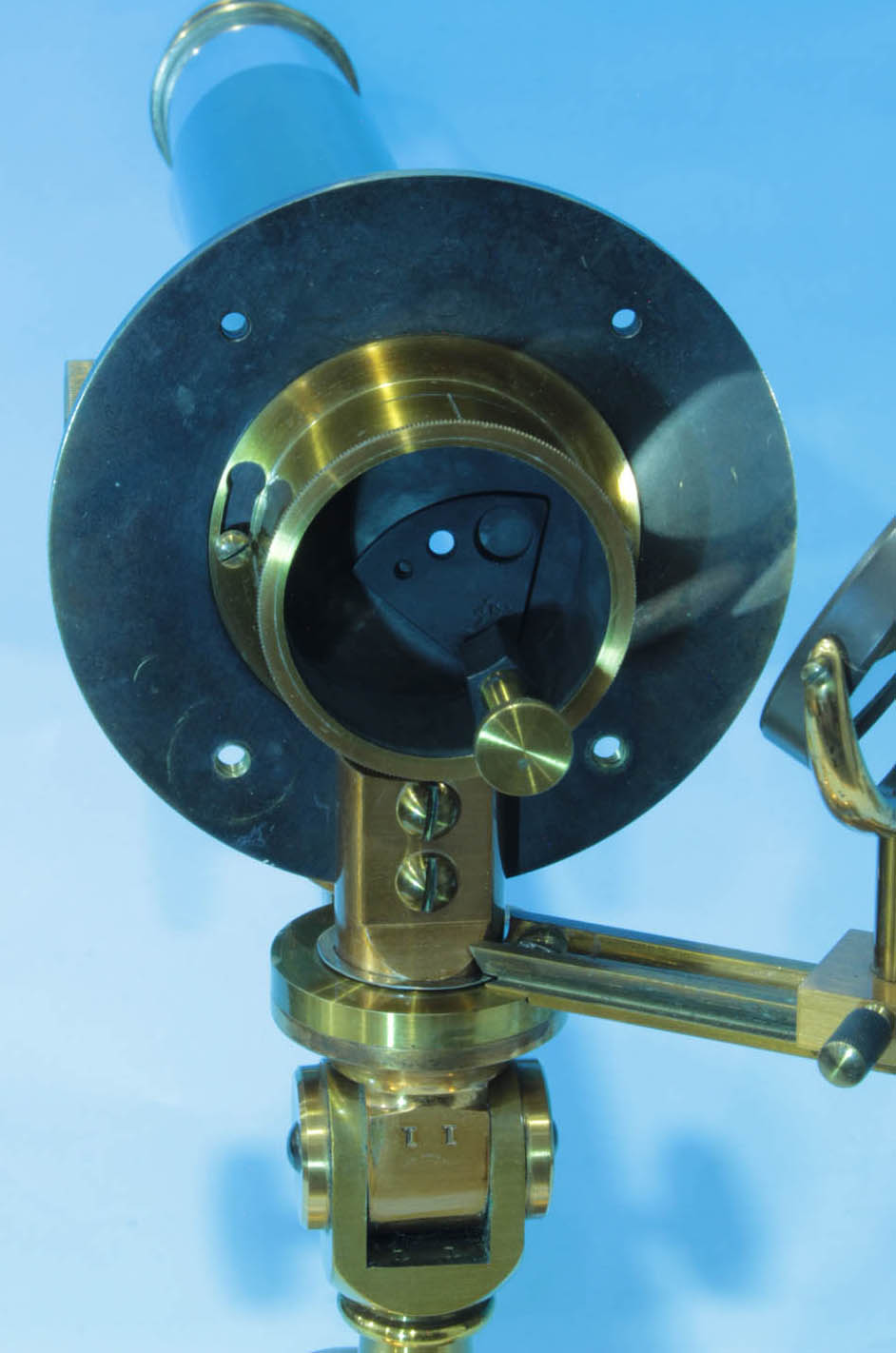 The condenser mount is attached to the bottom of the stage by a bayonet fitting with screws serving as lugs. It houses the original 3-aperture sector of stops controlled by a small knob projecting downward. The coarse focus is by rack and pinon and the fine via a micrometer screw acting from the bottom of the limb, similar to stands by Acme(Sidle) and Charles Baker. There is a single nickel-plated draw tube.
The condenser mount is attached to the bottom of the stage by a bayonet fitting with screws serving as lugs. It houses the original 3-aperture sector of stops controlled by a small knob projecting downward. The coarse focus is by rack and pinon and the fine via a micrometer screw acting from the bottom of the limb, similar to stands by Acme(Sidle) and Charles Baker. There is a single nickel-plated draw tube.
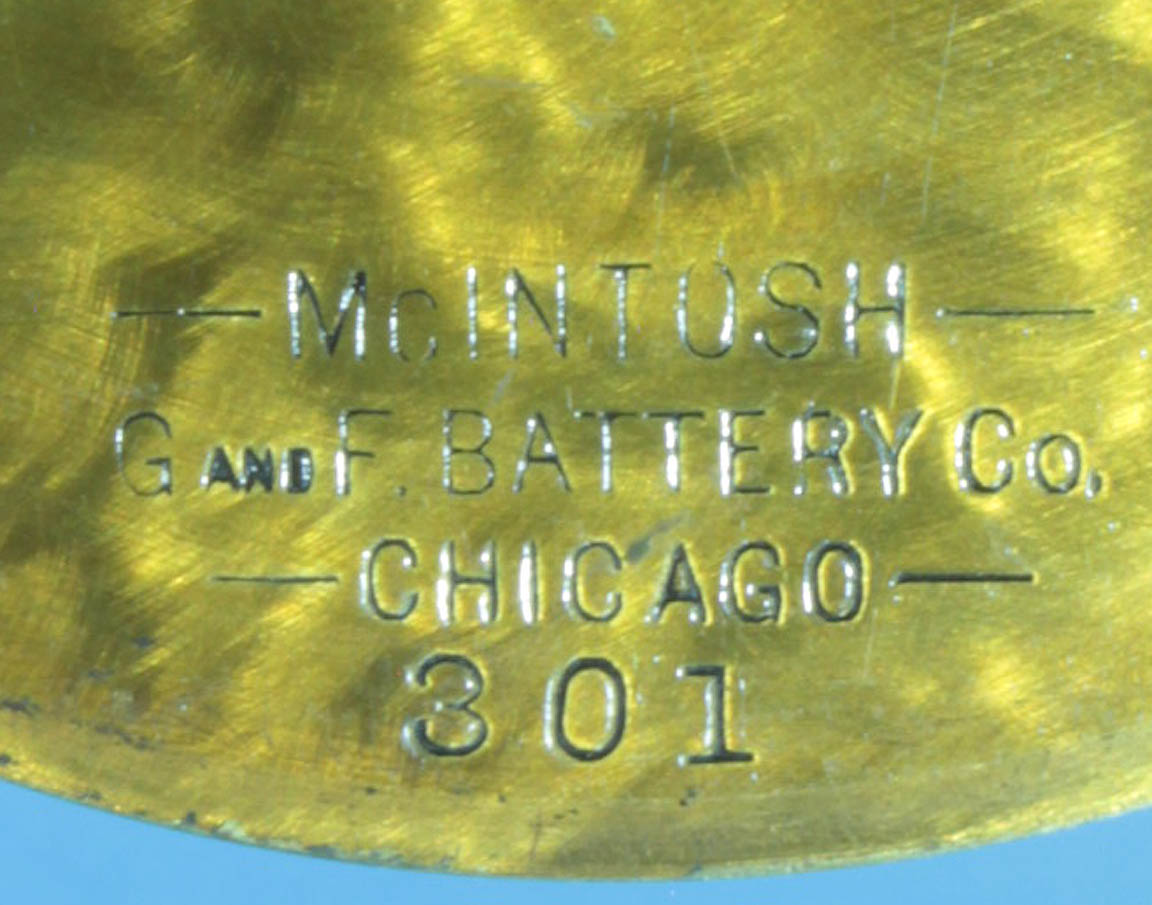 The decorative lacquered brass stage is signed:
The decorative lacquered brass stage is signed: -McINTOSH-, G AND F BATTERY Co., -CHICAGO-, 301
. This stands for The McIntosh Galvanic and Faradic Battery Company, one of the names used for the McIntosh company. 301 is presumably the serial number.
ACCESSORIES:
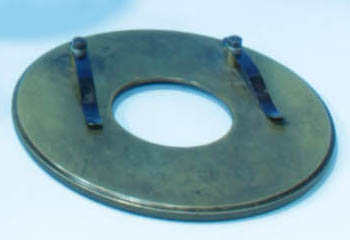 Accessories include an unlacquered working stage with stage clips which can rotate on top of the fancy-finished lacquered stage.
Accessories include an unlacquered working stage with stage clips which can rotate on top of the fancy-finished lacquered stage.
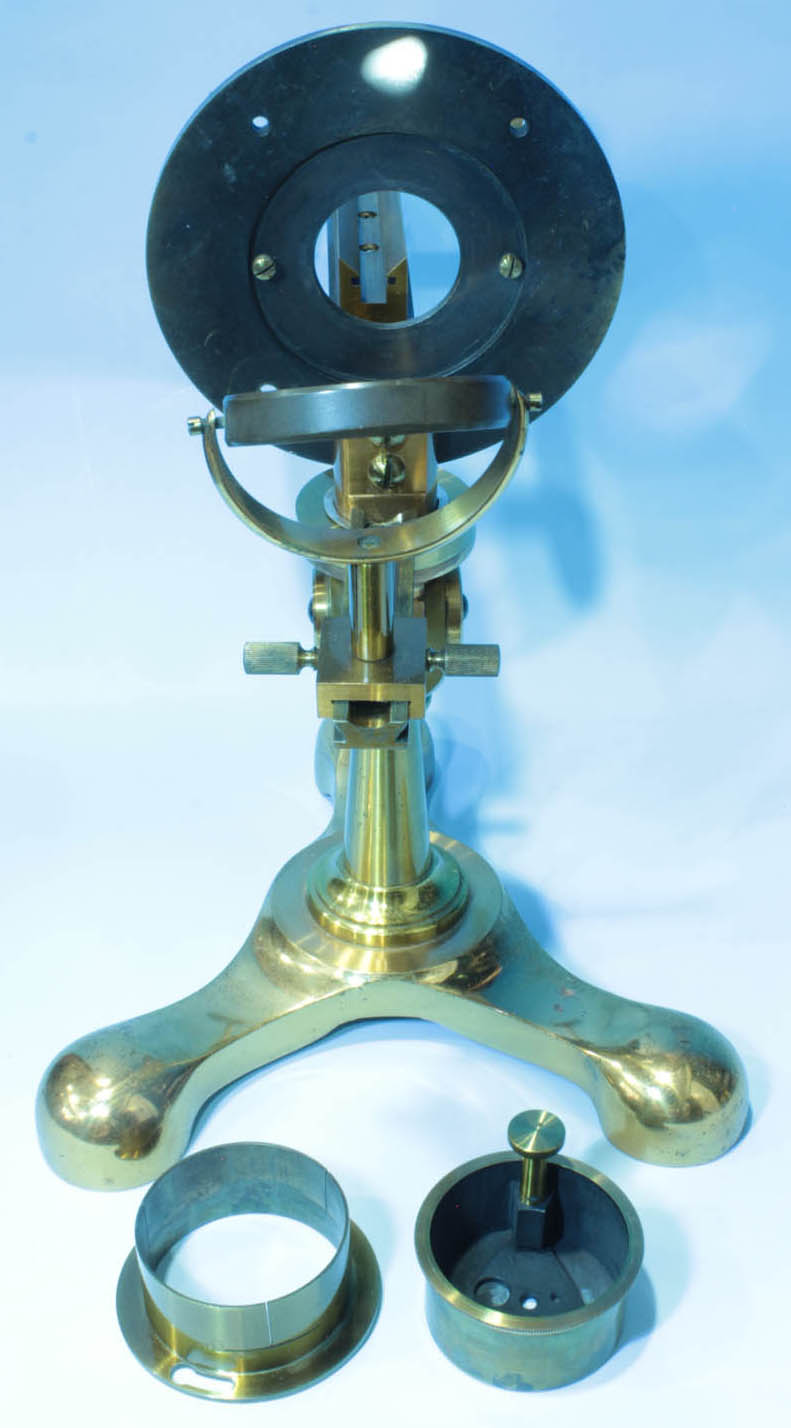 The diaphragm device can be removed and any other suitable substage accesory with an outside diameter of about 38.7 mm will fit the substage ring in its place.
The diaphragm device can be removed and any other suitable substage accesory with an outside diameter of about 38.7 mm will fit the substage ring in its place.
Two Bausch & Lomb Series I objectives are with the microscope. These are a 2/3 inch and a 1/6 inch focal length, both labeled for 160 mm tube length and with their n.a. of 0.25 and 0.82 respectively. There is a single unlabeled moderate power tophat
eyepiece.
The original case with lock and key are with the instrument as well. The case has a single drawer for accessories, but no fittings in the drawer.
HISTORY:
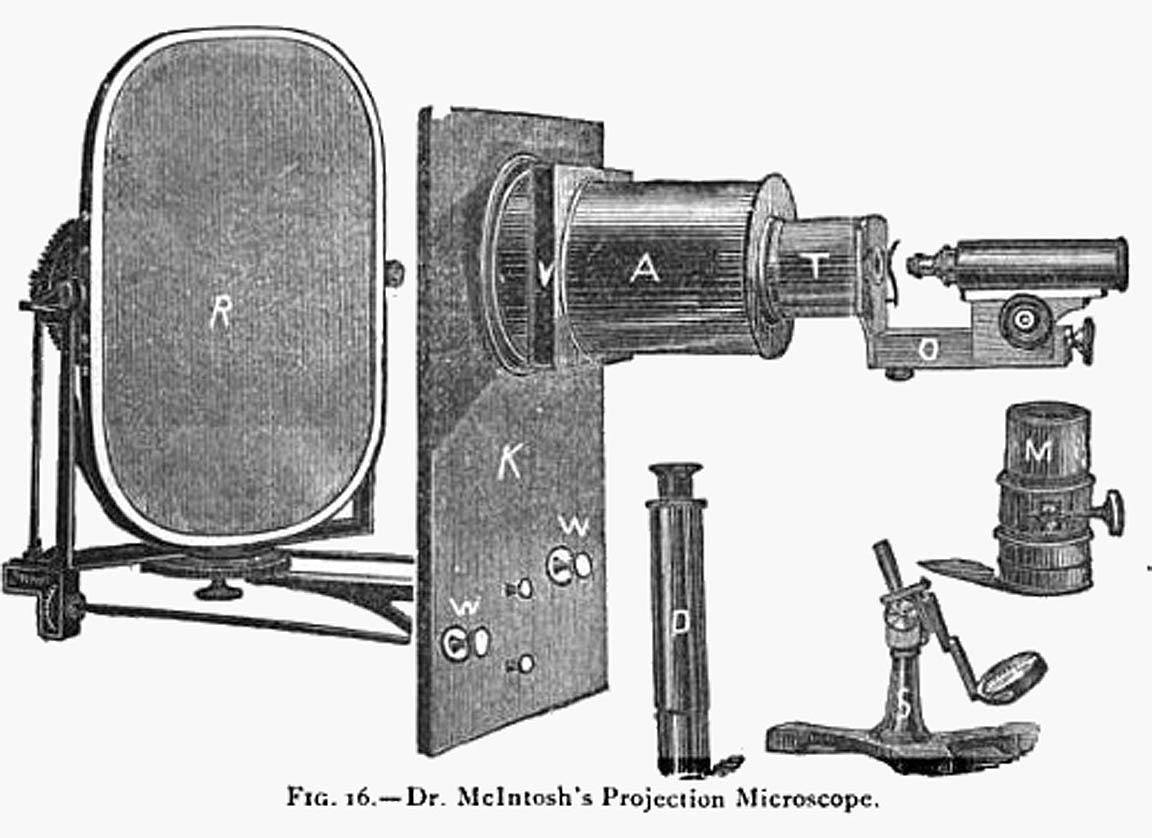
Lyman McIntosh was a physician who became an instrument and battery maker. The McIntosh Battery & Optical company specialized in projection apparatus, batteries, and also sold about 3 types of basic microscopes. Projection apparatus included Steropticons
which projected superimposed images giving a pseudo-3-D effect, solar-illuminated projection microscopes (of which an example shown to the left), and simple slide projectors called Sciopticons
. The microscopes included the Professional Model, The Scientific Models, and the Clinical Models. The Professional model was patented in 1883, but sold for years before that as part of the microscope projectors, both solar-lighted and artificially-lighted.

The first version is shown to the left, and can be seen in more detail on Allan Wissner's site. As shown in the figure, this model initally included a substage swinging tailpiece and plain stage clips. The main part of the Professional which included the optical tube, stage, and limb could be separated from the rest of the instrument and be used as part of a projection microscope or solar microscope as early as 1881.
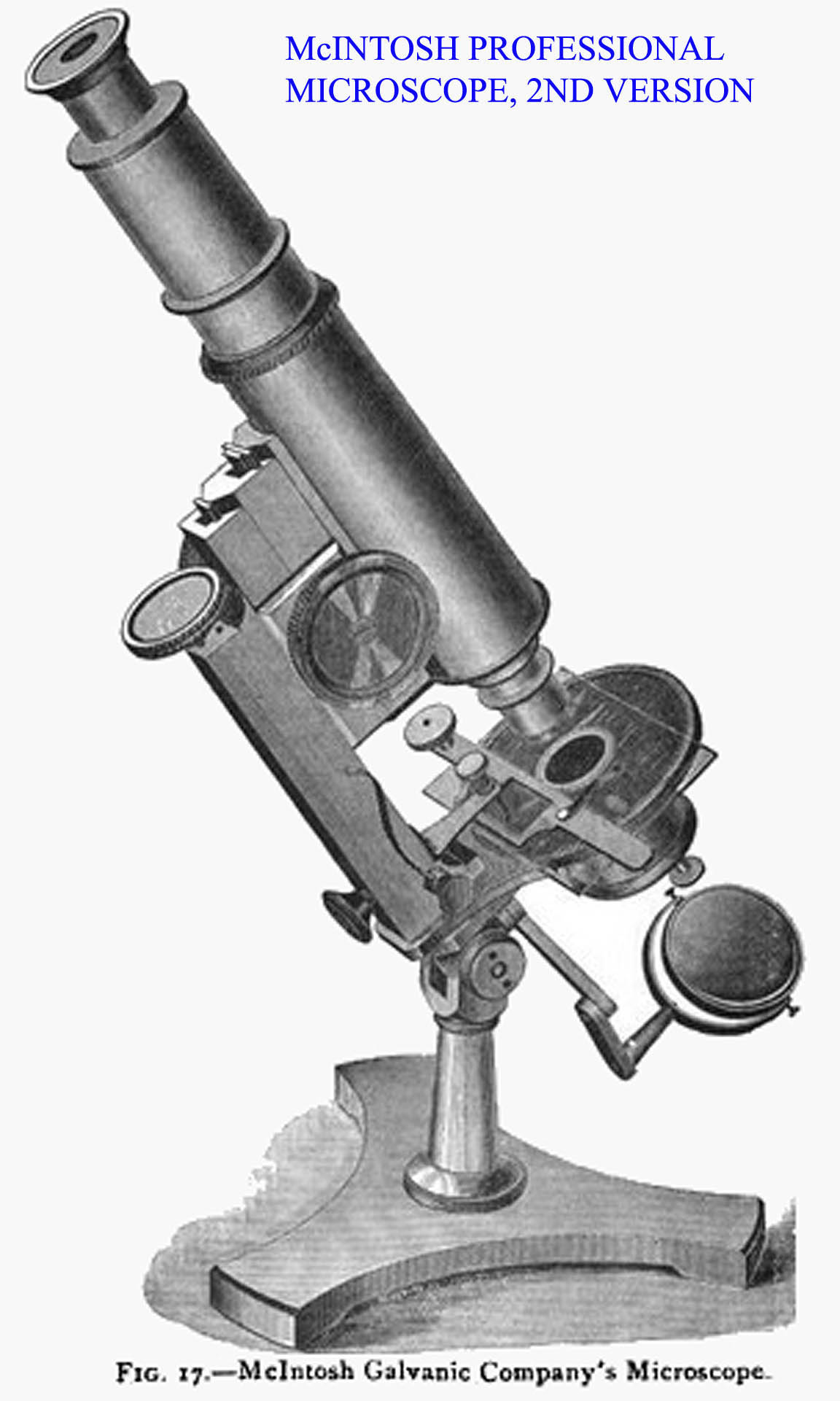
Although it initially had simple stage clips, a glide-stage*, which was invented earlier by Zentmayer, was added.
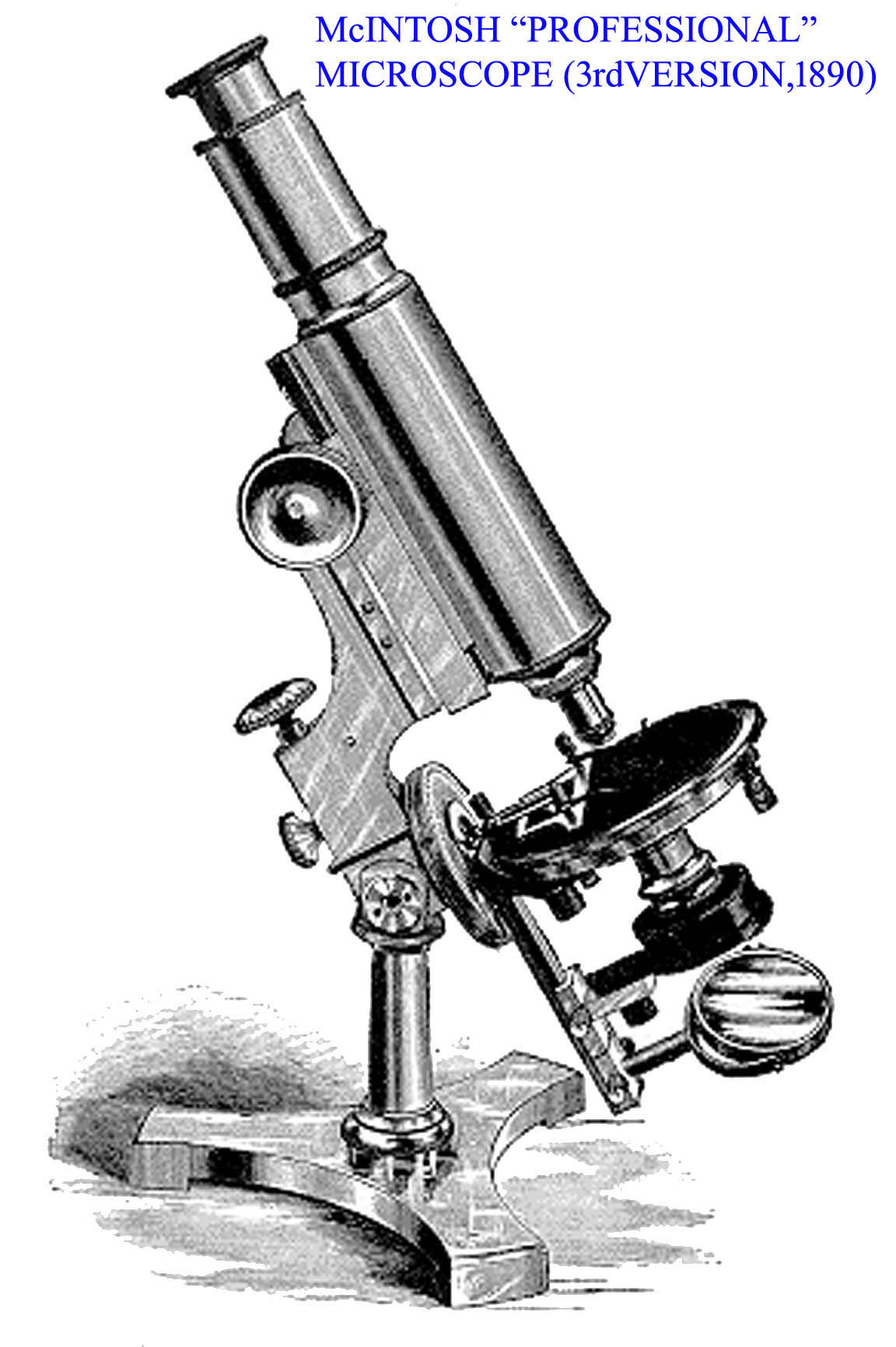
Subsequently another improvement was changing the axis of rotation of the swinging substage to be in line with the stage (another Zentmayer invention).
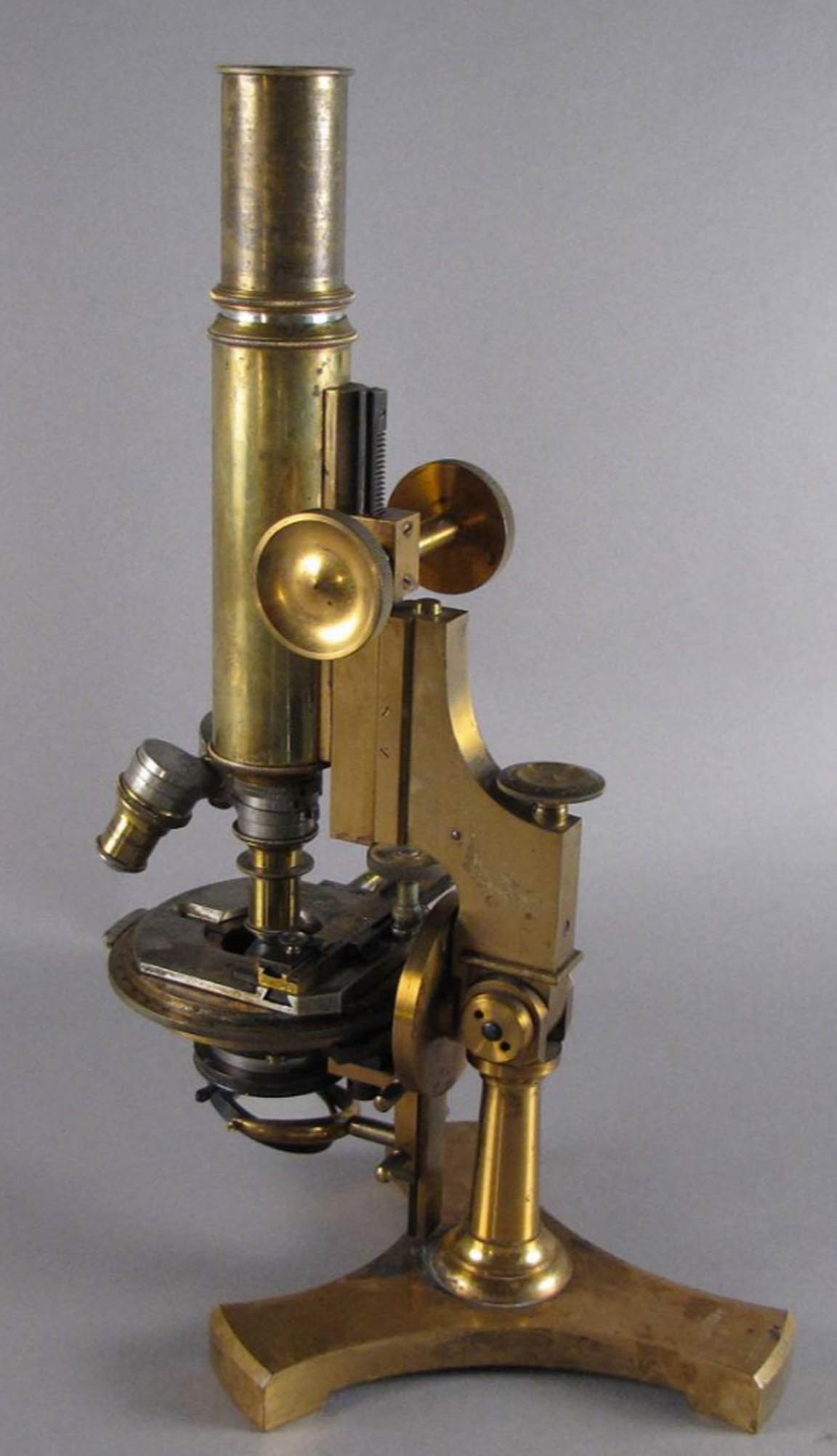
Lastly, some versions exist with a mechanical stage as the example from the Smithsonian shown here.
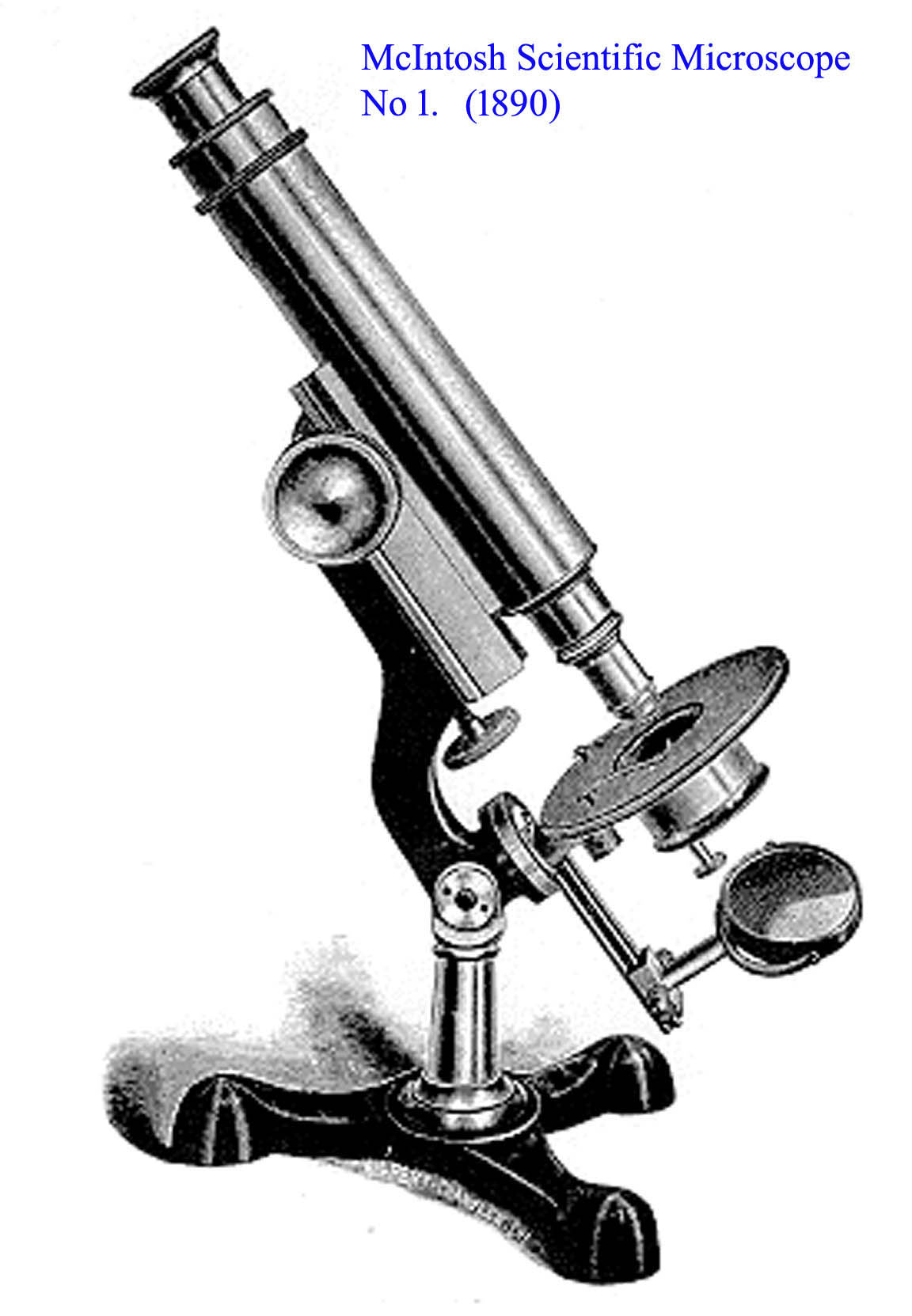
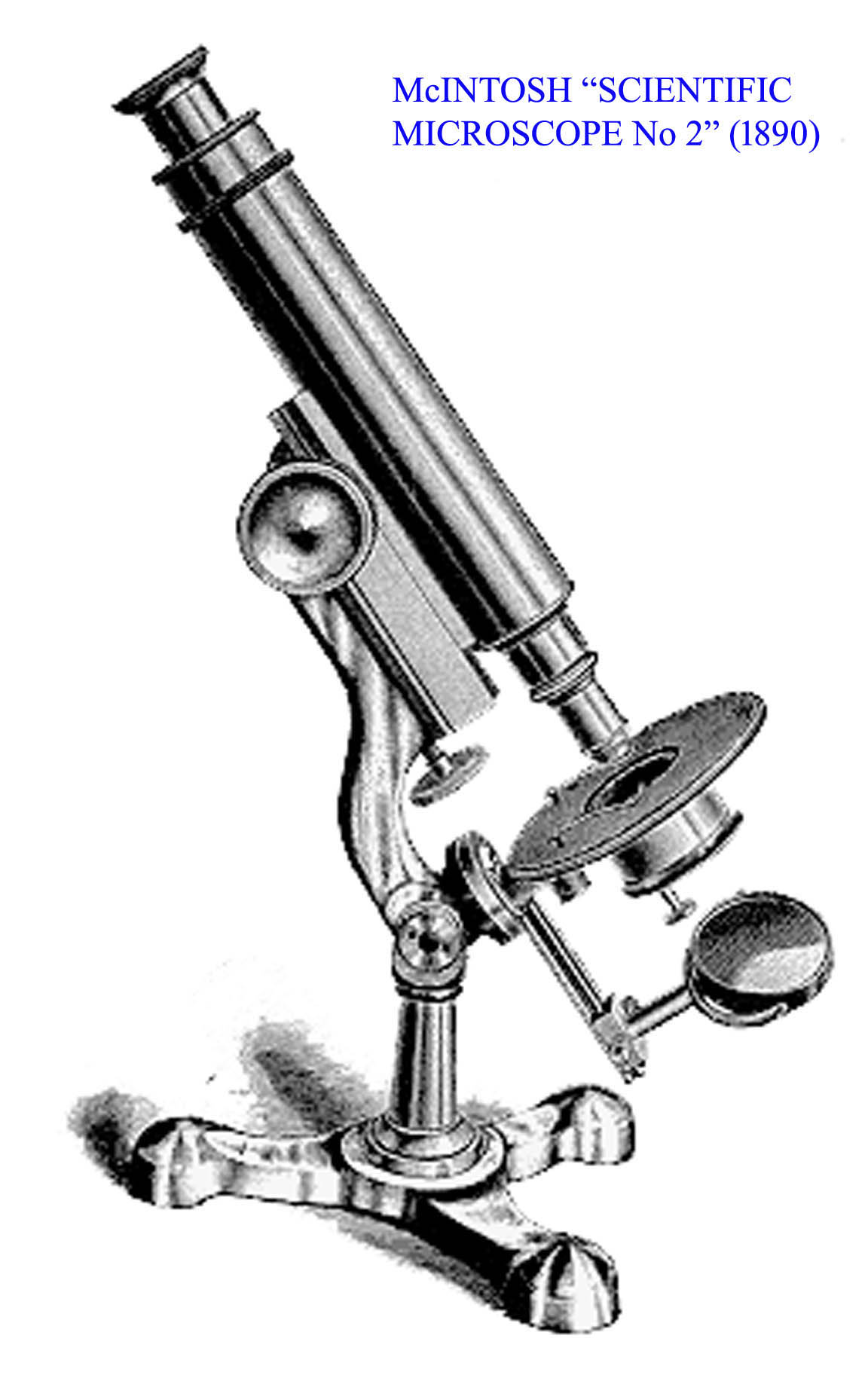 The Scientific microscope models, No 1 and No 2, were his second highest priced stands. The No 2 is featured on this page and has an all-lacquered brass finish, whereas the No 1 was a bit less expensive with a painted black foot and limb. They had the fine focus knob positioned under the limb.
The Scientific microscope models, No 1 and No 2, were his second highest priced stands. The No 2 is featured on this page and has an all-lacquered brass finish, whereas the No 1 was a bit less expensive with a painted black foot and limb. They had the fine focus knob positioned under the limb.
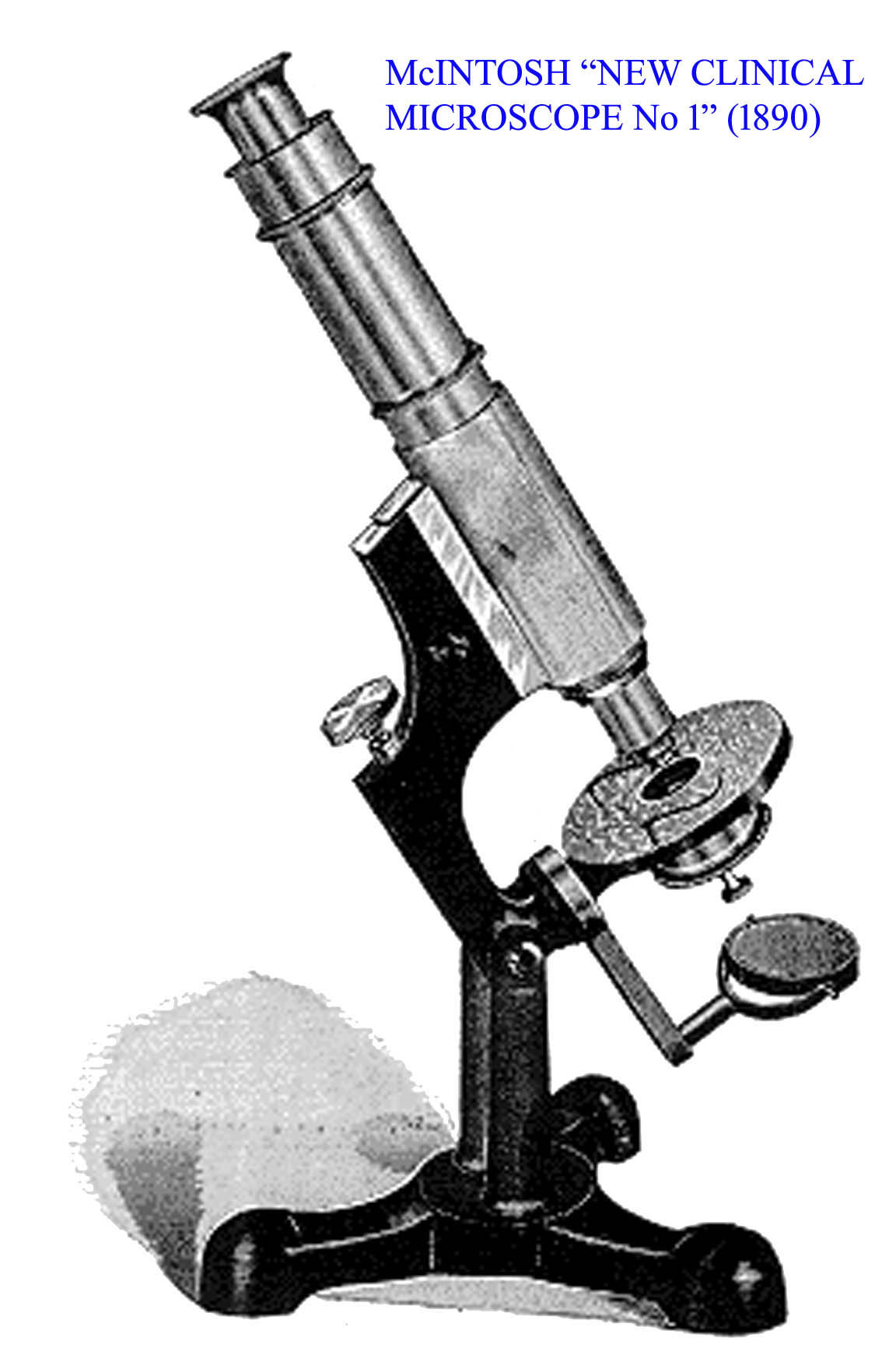
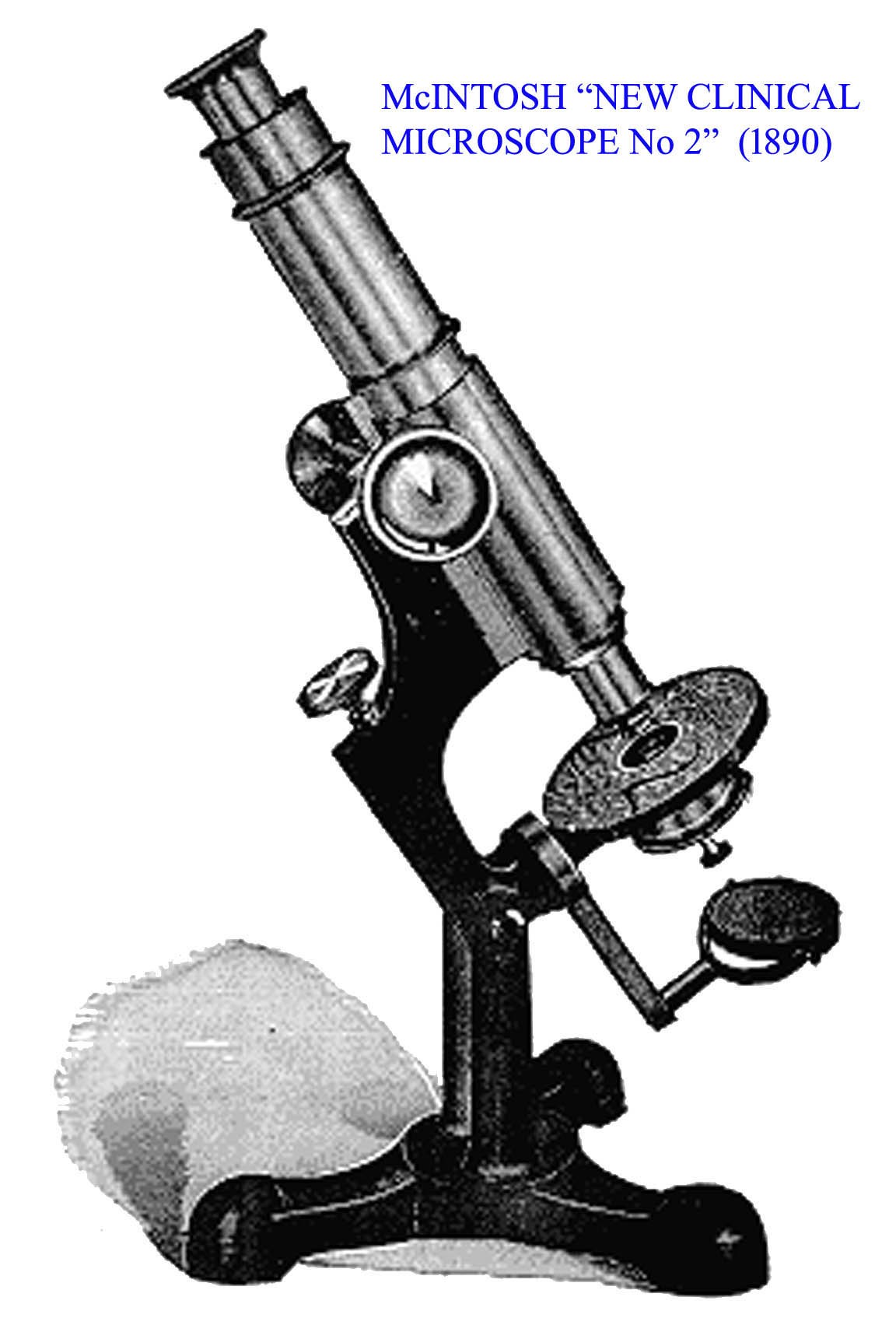 The
The New Clinical
models were a bit cheaper still. In this case they both had black painted foot and limb. The New Clinical No 1. had push-pull coarse focus, while the No 2 had rack and pinion coarse focus. Both had a micrometer screw fine focus acting on the top of the limb.
McIntosh headed a company that went by several names. These included a medical appliance company that specialized in an appliance to treat prolapse of the female organs called the McIntosh Natural Uterine Supporter Company
and his Battery companies that specialized in Medical Electrical Quack devices of all sizes and types, (including his Electric Chair
!). His companies were also referred to as the McIntosh Galvanic and Faradic Battery Company as well as the McIntosh Galvanic Belt and Battery Company, as well as the McIntosh Galvanic and Faradic Battery company, and by 1889 the McIntosh Battery and Optical Company. In his 1885 Illustrated Catalog, only the Professional Microscope was listed, along with Wales objectives. In that illustration, the engraving shows the microscope equipped with a glide stage. However McIntosh advertised Monocular and Binocular Microscopes
even earlier, so it is difficult to know exactly when he started to sell the other models.
Interestingly, McIntosh microscopes are quite uncommon. In 1975, Padgitt wrote there were only two known, but since then several others have come to market, the one featured on this web page being an example the author bought on Ebay in 2024, it previously being sold in auction some years earlier.
SOME DATES:
c. 1880, 1881: McIntosh Galvanic Belt and Battery Co 192 & 194 Jackson St Chicago
c. 1882-1885-?1889: McIntosh Galvanic and Faradic Battery Co 192 & 194 Jackson St Chicago
c. 1889-1897-?: McIntosh Battery & Optical Co 141-143 Wabash Ave Chicago
CONDITION:
The microscope is in fine working condition with most of the original lacquer nicely preserved. There are trivial scratches on the instrument and slight lacquer losses particularly on the foot. Mechanical parts all work well and the case is in very fine sound condition. The finish on the stage is in remarkably good condition thanks to the accessory stage which fits on top of it. The objectives and cans are almost like new.
*A glide stage is a holder for a slide that moves on top of the main stage with a contact surface of smaller surface area, that is easier to move small distances than if the slide were placed directly on the stage. This is a more precise way to move a slide than pushing the slide alone, but not as precise as a mechanical stage driven via e.g. racks and pinions.
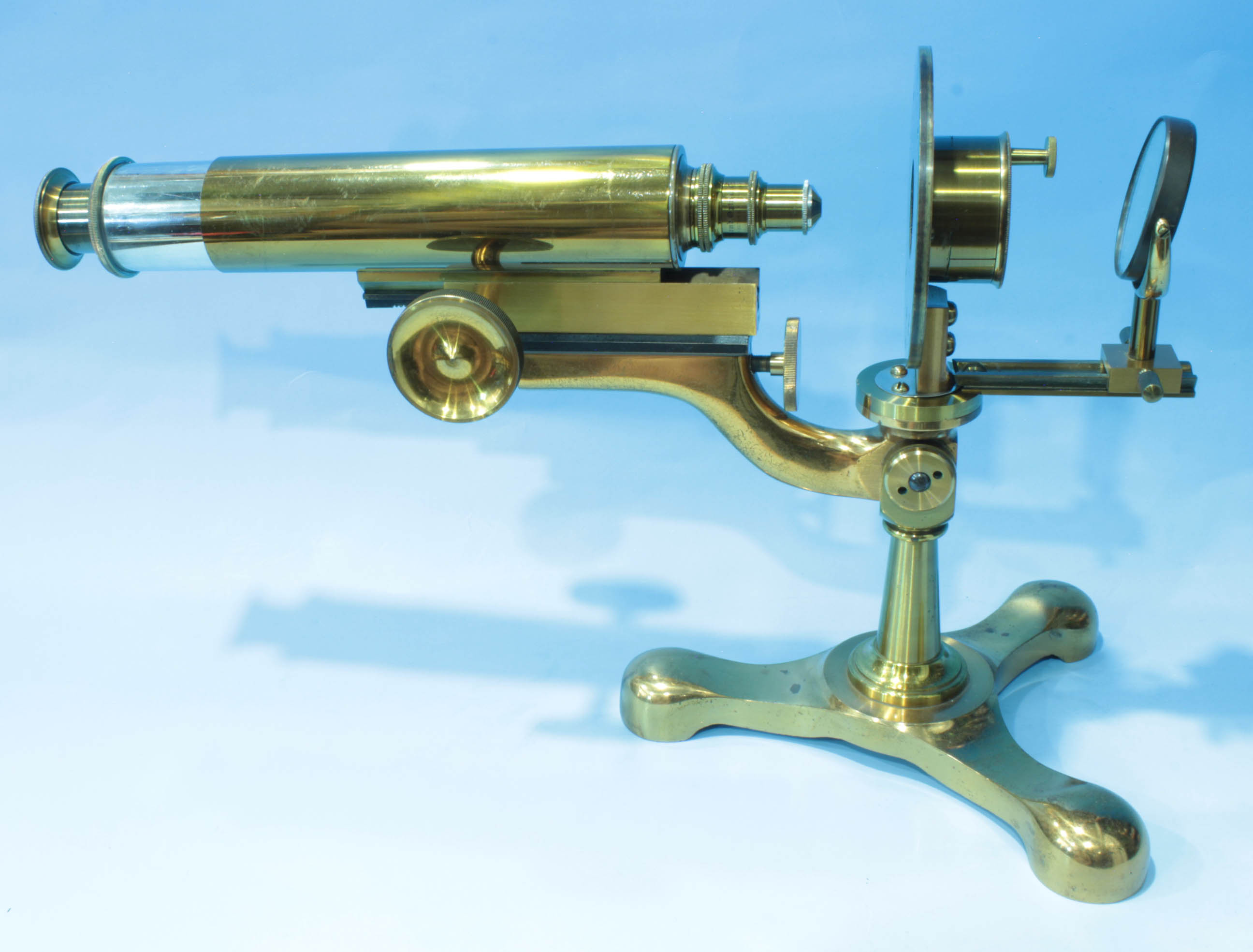
 The condenser mount is attached to the bottom of the stage by a bayonet fitting with screws serving as lugs. It houses the original 3-aperture sector of stops controlled by a small knob projecting downward. The coarse focus is by rack and pinon and the fine via a micrometer screw acting from the bottom of the limb, similar to stands by Acme(Sidle) and Charles Baker. There is a single nickel-plated draw tube.
The condenser mount is attached to the bottom of the stage by a bayonet fitting with screws serving as lugs. It houses the original 3-aperture sector of stops controlled by a small knob projecting downward. The coarse focus is by rack and pinon and the fine via a micrometer screw acting from the bottom of the limb, similar to stands by Acme(Sidle) and Charles Baker. There is a single nickel-plated draw tube.
 The decorative lacquered brass stage is signed:
The decorative lacquered brass stage is signed:  Accessories include an unlacquered working stage with stage clips which can rotate on top of the fancy-finished lacquered stage.
Accessories include an unlacquered working stage with stage clips which can rotate on top of the fancy-finished lacquered stage.  The diaphragm device can be removed and any other suitable substage accesory with an outside diameter of about 38.7 mm will fit the substage ring in its place.
The diaphragm device can be removed and any other suitable substage accesory with an outside diameter of about 38.7 mm will fit the substage ring in its place.





 The Scientific microscope models, No 1 and No 2, were his second highest priced stands. The No 2 is featured on this page and has an all-lacquered brass finish, whereas the No 1 was a bit less expensive with a painted black foot and limb. They had the fine focus knob positioned under the limb.
The Scientific microscope models, No 1 and No 2, were his second highest priced stands. The No 2 is featured on this page and has an all-lacquered brass finish, whereas the No 1 was a bit less expensive with a painted black foot and limb. They had the fine focus knob positioned under the limb.
 The
The 